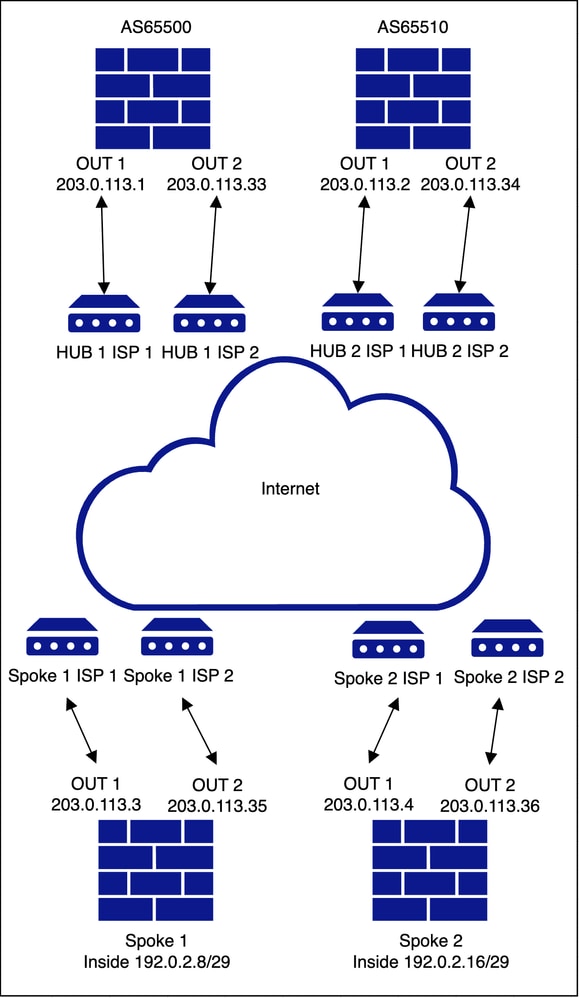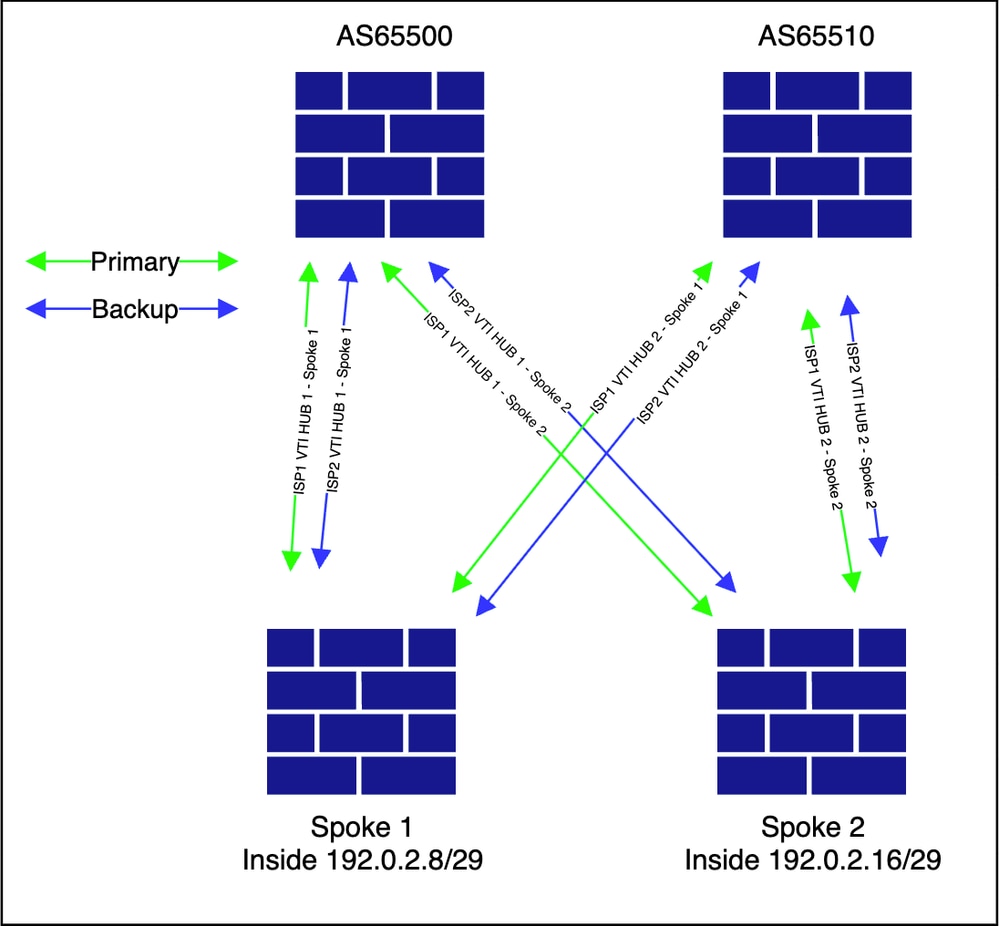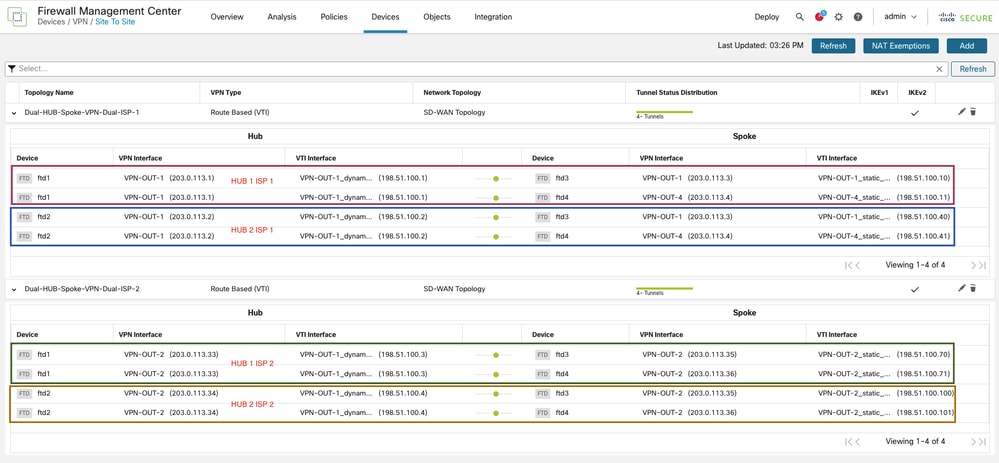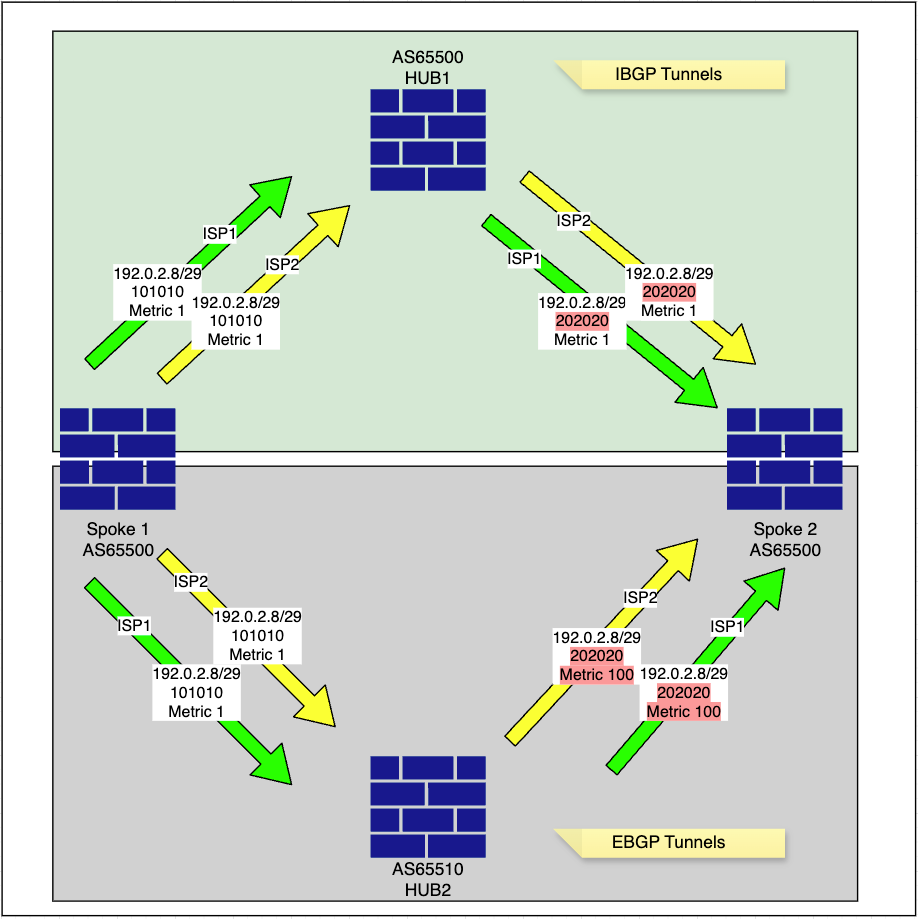Routenkontrolle in SD-WAN-Bereitstellungen mit sicheren Firewalls verstehen und Fehlerbehebung dafür durchführen
Download-Optionen
-
ePub (502.5 KB)
In verschiedenen Apps auf iPhone, iPad, Android, Sony Reader oder Windows Phone anzeigen
Inklusive Sprache
In dem Dokumentationssatz für dieses Produkt wird die Verwendung inklusiver Sprache angestrebt. Für die Zwecke dieses Dokumentationssatzes wird Sprache als „inklusiv“ verstanden, wenn sie keine Diskriminierung aufgrund von Alter, körperlicher und/oder geistiger Behinderung, Geschlechtszugehörigkeit und -identität, ethnischer Identität, sexueller Orientierung, sozioökonomischem Status und Intersektionalität impliziert. Dennoch können in der Dokumentation stilistische Abweichungen von diesem Bemühen auftreten, wenn Text verwendet wird, der in Benutzeroberflächen der Produktsoftware fest codiert ist, auf RFP-Dokumentation basiert oder von einem genannten Drittanbieterprodukt verwendet wird. Hier erfahren Sie mehr darüber, wie Cisco inklusive Sprache verwendet.
Informationen zu dieser Übersetzung
Cisco hat dieses Dokument maschinell übersetzen und von einem menschlichen Übersetzer editieren und korrigieren lassen, um unseren Benutzern auf der ganzen Welt Support-Inhalte in ihrer eigenen Sprache zu bieten. Bitte beachten Sie, dass selbst die beste maschinelle Übersetzung nicht so genau ist wie eine von einem professionellen Übersetzer angefertigte. Cisco Systems, Inc. übernimmt keine Haftung für die Richtigkeit dieser Übersetzungen und empfiehlt, immer das englische Originaldokument (siehe bereitgestellter Link) heranzuziehen.
Inhalt
Einleitung
In diesem Dokument wird die Routing-Kontrolle in BGP für routenbasierte VPNs beschrieben, die Cisco SD-WAN in einer sicheren Firewall verwenden.
Voraussetzungen
Anforderungen
Cisco empfiehlt, dass Sie über Kenntnisse in folgenden Bereichen verfügen:
- IKEv2
- Routenbasiertes VPN
- Virtuelle Tunnelschnittstellen (VTI)
- IPsec
- BGP
- BGP-Attribute wie Community-Tags und Routen-Reflektoren
- SD-WAN-Funktion in einer sicheren Firewall
Verwendete Komponenten
Die Informationen in diesem Dokument basieren auf:
- Cisco Secure Firewall Threat Defense 7.7.10
- Cisco Secure Firewall Management Center 7.7.10
Die Informationen in diesem Dokument beziehen sich auf Geräte in einer speziell eingerichteten Testumgebung. Alle Geräte, die in diesem Dokument benutzt wurden, begannen mit einer gelöschten (Nichterfüllungs) Konfiguration. Wenn Ihr Netzwerk in Betrieb ist, stellen Sie sicher, dass Sie die möglichen Auswirkungen aller Befehle kennen.
Informationen zu Funktionen
Mit der neuen SD-WAN-Bereitstellung für ein standortübergreifendes, routenbasiertes VPN mit aktiviertem BGP für das Overlay legt Cisco den Schwerpunkt auf wichtige BGP-Attribute zur Implementierung eines schleifenfreien und sicheren Overlay-Routings, wodurch sichergestellt wird, dass die Underlay- und Overlay-Netzwerke in der Topologie voneinander getrennt bleiben. Diese Bereitstellung stellt außerdem sicher, dass kein manueller Eingriff erforderlich ist, um die relevanten Attribute anzupassen.
Bereitstellungsszenario
Wählen Sie eine Topologie aus, die sowohl iBGP- als auch eBGP-Verbindungen zwischen HUB und Spoke umfasst. Dieser Ansatz bietet eine maximale Transparenz der Routing-Kontrollen, die als Teil der SD-WAN-Lösung in den Cisco Secure Firewalls implementiert sind.
Zwei HUBs und Spokes mit zwei ISPs
Underlay-Topologie

Overlay-Topologie

Konfiguration
Da das Hauptziel dieses Dokuments darin besteht, ein klares Verständnis der Routing-Steuerung zu vermitteln, die im Rahmen der SD-WAN-Bereitstellung auf einer sicheren Firewall implementiert wurde, werden die grundlegenden Konfigurationsschritte zur Bereitstellung der Topologie nicht erneut beschrieben. Eine detaillierte Anleitung zur Ersteinrichtung finden Sie in unserem zuvor veröffentlichten Dokument Configure SD-WAN for Site-to-Site VPN over Secure Firewall (Konfigurieren von SD-WAN für Site-to-Site-VPN über eine sichere Firewall).
Alle Konfigurationen im CLI-Abschnitt werden mithilfe des SD-WAN-Konfigurationsassistenten angewendet. Es werden keine Änderungen oder Modifikationen separat an der BGP-Konfiguration oder an den Routing-Map-Konfigurationen vorgenommen.

Überprüfung und Fehlerbehebung
Die Community-Liste filtert eingehende und ausgehende Präfixe. Eine ausführliche Erklärung finden Sie im Abschnitt zur Community-Liste der Cisco Dokumentation im Cisco Secure Firewall Management Center Device Configuration Guide.
Einheitliche Konfiguration für alle Geräte
firepower# show running-config community-list
community-list standard FMC_VPN_COMMUNITY_101010 permit 101010 <<<<<<<<<<
community-list standard FMC_VPN_COMMUNITY_202020 permit 202020 <<<<<<<<<<
Beachten Sie, dass es für jede Topologie ein Paar von eingehenden und ausgehenden Routing-Maps gibt, obwohl die Konfigurationen für beide Topologien identisch sind. Die Namenskonvention ist jedoch für jede Topologie eindeutig. In unserem Szenario sind FMC_VPN_RMAP_COMMUNITY_IN_858.99.39.614 und FMC_VPN_RMAP_COMMUNITY_OUT_85.89.99.39.614 für Topologie 1 während FMC_VPN_RMAP_COMMUNITY_IN_858942200 und FMC_VPN_RMAP_COMMUNITY_OUT_8589942200 sind für Topologie 2.
firepower# show running-config route-map
Topology 1
Inbound
route-map FMC_VPN_RMAP_COMMUNITY_IN_8589939614 permit 10
match community FMC_VPN_COMMUNITY_101010 exact-match
set community 202020
route-map FMC_VPN_RMAP_COMMUNITY_IN_8589939614 permit 20
match community FMC_VPN_COMMUNITY_202020 exact-match
Outbound
route-map FMC_VPN_RMAP_COMMUNITY_OUT_8589939614 permit 10
match community FMC_VPN_COMMUNITY_101010 exact-match
set metric 1
route-map FMC_VPN_RMAP_COMMUNITY_OUT_8589939614 permit 20
match community FMC_VPN_COMMUNITY_202020 exact-match
set metric 100
route-map FMC_VPN_RMAP_COMMUNITY_OUT_8589939614 deny 100
Topology 2
Inbound
route-map FMC_VPN_RMAP_COMMUNITY_IN_8589942200 permit 10
match community FMC_VPN_COMMUNITY_101010 exact-match
set community 202020
route-map FMC_VPN_RMAP_COMMUNITY_IN_8589942200 permit 20
match community FMC_VPN_COMMUNITY_202020 exact-match
Outbound
route-map FMC_VPN_RMAP_COMMUNITY_OUT_8589942200 permit 10
match community FMC_VPN_COMMUNITY_101010 exact-match
set metric 1
route-map FMC_VPN_RMAP_COMMUNITY_OUT_8589942200 permit 20
match community FMC_VPN_COMMUNITY_202020 exact-match
set metric 100
route-map FMC_VPN_RMAP_COMMUNITY_OUT_8589942200 deny 100
Common Across All The Hubs & Spokes Wherever Redistribution Of Inside Network Is Present
route-map FMC_VPN_CONNECTED_DIST_RMAP_101010 permit 10
match interface inside
set community 101010
Die BGP-Konfiguration für alle Geräte in der Topologie wird angezeigt:
Spoke1 und 2 (IBGP mit HUB1 und EBGP mit HUB2)
firepower# show running-config router bgp
router bgp 65500
bgp log-neighbor-changes
address-family ipv4 unicast
neighbor 198.51.100.1 remote-as 65500 <<<<< tunnel from spokes to HUB 1 via ISP1
neighbor 198.51.100.1 activate
neighbor 198.51.100.1 send-community
neighbor 198.51.100.1 route-map FMC_VPN_RMAP_COMMUNITY_IN_8589939614 in
neighbor 198.51.100.1 route-map FMC_VPN_RMAP_COMMUNITY_OUT_8589939614 out
neighbor 198.51.100.2 remote-as 65510 <<<<< tunnel from spokes to HUB 2 via ISP1
neighbor 198.51.100.2 ebgp-multihop 2
neighbor 198.51.100.2 activate
neighbor 198.51.100.2 send-community
neighbor 198.51.100.2 route-map FMC_VPN_RMAP_COMMUNITY_IN_8589939614 in
neighbor 198.51.100.2 route-map FMC_VPN_RMAP_COMMUNITY_OUT_8589939614 out
neighbor 198.51.100.3 remote-as 65500 <<<<< tunnel from spokes to HUB 1 via ISP2
neighbor 198.51.100.3 activate
neighbor 198.51.100.3 send-community
neighbor 198.51.100.3 route-map FMC_VPN_RMAP_COMMUNITY_IN_8589942200 in
neighbor 198.51.100.3 route-map FMC_VPN_RMAP_COMMUNITY_OUT_8589942200 out
neighbor 198.51.100.4 remote-as 65510 <<<<< tunnel from spokes to HUB 2 via ISP2
neighbor 198.51.100.4 ebgp-multihop 2
neighbor 198.51.100.4 activate
neighbor 198.51.100.4 send-community
neighbor 198.51.100.4 route-map FMC_VPN_RMAP_COMMUNITY_IN_8589942200 in
neighbor 198.51.100.4 route-map FMC_VPN_RMAP_COMMUNITY_OUT_8589942200 out
redistribute connected route-map FMC_VPN_CONNECTED_DIST_RMAP_101010 <<<<<<< route-map to redistribute inside network into BGP
maximum-paths 8
maximum-paths ibgp 8
no auto-summary
no synchronization
exit-address-family
HUB1 (IBGP-Peering mit den Spokes)
firepower# show running-config router bgp
router bgp 65500
bgp log-neighbor-changes
address-family ipv4 unicast
neighbor 198.51.100.10 remote-as 65500 <<<<< tunnel from HUB 1 to Spoke 1 via ISP 1
neighbor 198.51.100.10 activate
neighbor 198.51.100.10 send-community
neighbor 198.51.100.10 route-reflector-client
neighbor 198.51.100.10 next-hop-self
neighbor 198.51.100.10 route-map FMC_VPN_RMAP_COMMUNITY_IN_8589939614 in
neighbor 198.51.100.10 route-map FMC_VPN_RMAP_COMMUNITY_OUT_8589939614 out
neighbor 198.51.100.11 remote-as 65500 <<<<< tunnel from HUB 1 to Spoke 2 via ISP 1
neighbor 198.51.100.11 activate
neighbor 198.51.100.11 send-community
neighbor 198.51.100.11 route-reflector-client
neighbor 198.51.100.11 next-hop-self
neighbor 198.51.100.11 route-map FMC_VPN_RMAP_COMMUNITY_IN_8589939614 in
neighbor 198.51.100.11 route-map FMC_VPN_RMAP_COMMUNITY_OUT_8589939614 out
neighbor 198.51.100.70 remote-as 65500 <<<<< tunnel from HUB 1 to Spoke 1 via ISP 2
neighbor 198.51.100.70 activate
neighbor 198.51.100.70 send-community
neighbor 198.51.100.70 route-reflector-client
neighbor 198.51.100.70 next-hop-self
neighbor 198.51.100.70 route-map FMC_VPN_RMAP_COMMUNITY_IN_8589942200 in
neighbor 198.51.100.70 route-map FMC_VPN_RMAP_COMMUNITY_OUT_8589942200 out
neighbor 198.51.100.71 remote-as 65500 <<<<< tunnel from HUB 1 to Spoke 2 via ISP 2
neighbor 198.51.100.71 activate
neighbor 198.51.100.71 send-community
neighbor 198.51.100.71 route-reflector-client
neighbor 198.51.100.71 next-hop-self
neighbor 198.51.100.71 route-map FMC_VPN_RMAP_COMMUNITY_IN_8589942200 in
neighbor 198.51.100.71 route-map FMC_VPN_RMAP_COMMUNITY_OUT_8589942200 out
no auto-summary
no synchronization
exit-address-family
HUB2 (EBGP-Peering mit den Spokes)
firepower# show running-config router bgp
router bgp 65510
bgp log-neighbor-changes
address-family ipv4 unicast
neighbor 198.51.100.40 remote-as 65500 <<<<< tunnel from HUB 2 to Spoke 1 via ISP 1
neighbor 198.51.100.40 ebgp-multihop 2
neighbor 198.51.100.40 activate
neighbor 198.51.100.40 send-community
neighbor 198.51.100.40 next-hop-self
neighbor 198.51.100.40 as-override
neighbor 198.51.100.40 route-map FMC_VPN_RMAP_COMMUNITY_IN_8589939614 in
neighbor 198.51.100.40 route-map FMC_VPN_RMAP_COMMUNITY_OUT_8589939614 out
neighbor 198.51.100.41 remote-as 65500 <<<<< tunnel from HUB 2 to Spoke 2 via ISP 1
neighbor 198.51.100.41 ebgp-multihop 2
neighbor 198.51.100.41 activate
neighbor 198.51.100.41 send-community
neighbor 198.51.100.41 next-hop-self
neighbor 198.51.100.41 as-override
neighbor 198.51.100.41 route-map FMC_VPN_RMAP_COMMUNITY_IN_8589939614 in
neighbor 198.51.100.41 route-map FMC_VPN_RMAP_COMMUNITY_OUT_8589939614 out
neighbor 198.51.100.100 remote-as 65500 <<<<< tunnel from HUB 2 to Spoke 1 via ISP 2
neighbor 198.51.100.100 ebgp-multihop 2
neighbor 198.51.100.100 activate
neighbor 198.51.100.100 send-community
neighbor 198.51.100.100 next-hop-self
neighbor 198.51.100.100 as-override
neighbor 198.51.100.100 route-map FMC_VPN_RMAP_COMMUNITY_IN_8589942200 in
neighbor 198.51.100.100 route-map FMC_VPN_RMAP_COMMUNITY_OUT_8589942200 out
neighbor 198.51.100.101 remote-as 65500 <<<<< tunnel from HUB 2 to Spoke 2 via ISP 2
neighbor 198.51.100.101 ebgp-multihop 2
neighbor 198.51.100.101 activate
neighbor 198.51.100.101 send-community
neighbor 198.51.100.101 next-hop-self
neighbor 198.51.100.101 as-override
neighbor 198.51.100.101 route-map FMC_VPN_RMAP_COMMUNITY_IN_8589942200 in
neighbor 198.51.100.101 route-map FMC_VPN_RMAP_COMMUNITY_OUT_8589942200 out
no auto-summary
no synchronization
exit-address-family
Routing-Topologie

-
Der Spoke meldet sein internes Netzwerk 192.0.2.8/29 an BGP mit einem spezifischen Community-Tag von 101010, wie in der Routing-Map FMC_VPN_CONNECTED_DIST_RMAP_1010 konfiguriert.
Speiche 1
Spoke1# show bgp community 101010 exact-match <<<< to verify the exact network redistributed into BGP
BGP table version is 4, local router ID is 203.0.113.35
Status codes: s suppressed, d damped, h history, * valid, > best, i - internal,
r RIB-failure, S Stale, m multipath
Origin codes: i - IGP, e - EGP, ? - incomplete
Network Next Hop Metric LocPrf Weight Path
*> 192.0.2.8/29 0.0.0.0 0 32768 ? <<<<<<<<<<< local inside network-
Der Spoke ändert den Metrikwert für sein internes Netzwerk 192.0.2.8/29 und kündigt ihn den Hubs an, wie in den Routenzuordnungen FMC_VPN_RMAP_COMMUNITY_OUT_858.993.9614 konfiguriert und FMC_VPN_RMAP_COMMUNITY_OUT_858.994.2200.
route-map FMC_VPN_RMAP_COMMUNITY_OUT_8589942200 permit 10
match community FMC_VPN_COMMUNITY_101010 exact-match
set metric 1
route-map FMC_VPN_RMAP_COMMUNITY_OUT_8589942200 permit 20
match community FMC_VPN_COMMUNITY_202020 exact-match
set metric 100
route-map FMC_VPN_RMAP_COMMUNITY_OUT_8589942200 deny 100
-
HUB1 lernt das Spoke 1-Netzwerk 192.0.2.8/29 mit dem Community-Tag 101010 und ändert das Community-Tag auf 202020, wobei die Metrik beibehalten wird, bevor sie an andere Stationen weitergeleitet wird, wie in den konfigurierten Routen-Maps definiert.
HUB1
Route-Map for ISP1 DVTI
Inbound
route-map FMC_VPN_RMAP_COMMUNITY_IN_8589939614 permit 10
match community FMC_VPN_COMMUNITY_101010 exact-match
set community 202020
route-map FMC_VPN_RMAP_COMMUNITY_IN_8589939614 permit 20
match community FMC_VPN_COMMUNITY_202020 exact-match
Outbound
route-map FMC_VPN_RMAP_COMMUNITY_OUT_8589939614 permit 10
match community FMC_VPN_COMMUNITY_101010 exact-match
set metric 1
set ip next-hop 198.51.100.1 <<<<<<<<<< only next-hop is changed in ISP2 tunnel route-map with ISP2 DVTI IP
route-map FMC_VPN_RMAP_COMMUNITY_OUT_8589939614 permit 20
match community FMC_VPN_COMMUNITY_202020 exact-match
set metric 100
set ip next-hop 198.51.100.1 <<<<<<<<<< only next-hop is changed in ISP2 tunnel route-map with ISP2 DVTI IP
route-map FMC_VPN_RMAP_COMMUNITY_OUT_8589939614 deny 100
Route-Map for ISP2 DVTI
Inbound
route-map FMC_VPN_RMAP_COMMUNITY_IN_8589942200 permit 10
match community FMC_VPN_COMMUNITY_101010 exact-match
set community 202020
route-map FMC_VPN_RMAP_COMMUNITY_IN_8589942200 permit 20
match community FMC_VPN_COMMUNITY_202020 exact-match
Outbound
route-map FMC_VPN_RMAP_COMMUNITY_OUT_8589942200 permit 10
match community FMC_VPN_COMMUNITY_101010 exact-match
set metric 1
set ip next-hop 198.51.100.3 <<<<<<<<<< only next-hop is changed in ISP2 tunnel route-map with ISP2 DVTI IP
route-map FMC_VPN_RMAP_COMMUNITY_OUT_8589942200 permit 20
match community FMC_VPN_COMMUNITY_202020 exact-match
set metric 100
set ip next-hop 198.51.100.3 <<<<<<<<<< only next-hop is changed in ISP2 tunnel route-map with ISP2 DVTI IP
route-map FMC_VPN_RMAP_COMMUNITY_OUT_8589942200 deny 100
HUB1# show bgp community 202020 exact-match <<<< this will confirm if received prefixes have community tags flipped
BGP table version is 5, local router ID is 198.51.100.3 Status codes: s suppressed, d damped, h history, * valid, > best, i - internal, r RIB-failure, S Stale, m multipath Origin codes: i - IGP, e - EGP, ? - incomplete Network Next Hop Metric LocPrf Weight Path * i192.0.2.8/29 198.51.100.70 1 100 0 ? *>i 198.51.100.10 1 100 0 ? * i192.0.2.16/29 198.51.100.71 1 100 0 ? *>i 198.51.100.11 1 100 0 ?
HUB1# show bgp 192.0.2.8 <<<< this will display available paths in BGP for the network
BGP routing table entry for 192.0.2.8/29, version 4 Paths: (2 available, best #2, table default) Advertised to update-groups: 1 2 Local, (Received from a RR-client) 198.51.100.70 from 198.51.100.70 (203.0.113.35) <<<<< spoke 1 ISP 2 tunnel to HUB 1 Origin incomplete, metric 1, localpref 100, valid, internal Community: 202020 Local, (Received from a RR-client) 198.51.100.10 from 198.51.100.10 (203.0.113.35) <<<<< spoke 1 ISP 1 tunnel to HUB 1 Origin incomplete, metric 1, localpref 100, valid, internal, best Community: 202020 <<<<< community updated as per the route-map configured on spoke side
HUB1# show route 192.0.2.8
Routing entry for 192.0.2.8 255.255.255.248
Known via "bgp 65500", distance 200, metric 1, type internal
Last update from 198.51.100.10 0:09:18 ago
Routing Descriptor Blocks:
* 198.51.100.10, from 198.51.100.10, 0:09:18 ago
Route metric is 1, traffic share count is 1
AS Hops 0
MPLS label: no label string providedHUB1# show bgp ipv4 unicast neighbors 198.51.100.10 routes <<<<<< to check specific prefixes learnt via ISP1 spoke1 tunnel
BGP table version is 5, local router ID is 198.51.100.3
Status codes: s suppressed, d damped, h history, * valid, > best, i - internal,
r RIB-failure, S Stale, m multipath
Origin codes: i - IGP, e - EGP, ? - incomplete
Network Next Hop Metric LocPrf Weight Path
*>i192.0.2.8/29 198.51.100.10 1 100 0 ? <<< preferred route
Total number of prefixes 1 HUB1# show bgp ipv4 unicast neighbors 198.51.100.70 routes <<<<<< to check specific prefixes learnt via ISP2 spoke1 tunnel
BGP table version is 5, local router ID is 198.51.100.3
Status codes: s suppressed, d damped, h history, * valid, > best, i - internal,
r RIB-failure, S Stale, m multipath
Origin codes: i - IGP, e - EGP, ? - incomplete
Network Next Hop Metric LocPrf Weight Path
* i192.0.2.8/29 198.51.100.70 1 100 0 ?
Total number of prefixes 1 -
HUB2 lernt auch das Spoke 1-Netzwerk 192.0.2.8/29 mit dem Community-Tag 101010, ändert das Community-Tag auf 202020 und aktualisiert die Metrik auf 100, bevor es an andere Stationen weitergeleitet wird, wie in den konfigurierten Routen-Maps angegeben. Diese Metrikänderung wird durch eBGP-Peering wirksam. MED (Multi-Exit Discriminator) ist ein optionales, nicht transitives BGP-Attribut, das zur Beeinflussung des eingehenden Datenverkehrs verwendet wird, indem ein bevorzugter Eintrittspunkt in ein AS vorgeschlagen wird. MED wird im Allgemeinen nicht zwischen iBGP-Peers innerhalb desselben AS propagiert und stattdessen externen BGP (eBGP)-Peers in verschiedenen autonomen Systemen angekündigt.
HUB2
HUB2# show bgp community 202020 exact-match <<<< this will confirm if receieved prefixes have community tags flipped
BGP table version is 5, local router ID is 198.51.100.4 Status codes: s suppressed, d damped, h history, * valid, > best, i - internal, r RIB-failure, S Stale, m multipath Origin codes: i - IGP, e - EGP, ? - incomplete Network Next Hop Metric LocPrf Weight Path * 192.0.2.8/29 198.51.100.1 100 0 65500 ? <<<<<< advertised back by spoke 2 ISP1 to HUB2 previously learnt via HUB1 iBGP * 198.51.100.1 100 0 65500 ? <<<<<< advertised back by spoke 2 ISP2 to HUB2 previously learnt via HUB1 iBGP * 198.51.100.100 1 0 65500 ? <<<<<< advertised by spoke 2 ISP tunnel *> 198.51.100.40 1 0 65500 ? <<<<<< advertised and preferred by spoke 1 ISP 1 tunnel * 192.0.2.16/29 198.51.100.1 100 0 65500 ? * 198.51.100.1 100 0 65500 ? * 198.51.100.101 1 0 65500 ? *> 198.51.100.41 1 0 65500 ?
HUB2# show bgp 192.0.2.8 <<<< this will display available paths in BGP for the network
BGP routing table entry for 192.0.2.8/29, version 4 Paths: (4 available, best #4, table default) Advertised to update-groups: 1 2 65500 198.51.100.1 (inaccessible) from 198.51.100.41 (203.0.113.36) <<<<<< advertised back by spoke 2 ISP1 to HUB2 previously learnt via HUB1 iBGP Origin incomplete, metric 100, localpref 100, valid, external Community: 202020 65500 198.51.100.1 (inaccessible) from 198.51.100.101 (203.0.113.36) <<<<<< advertised back by spoke 2 ISP2 to HUB2 previously learnt via HUB1 iBGP Origin incomplete, metric 100, localpref 100, valid, external Community: 202020 65500 198.51.100.100 from 198.51.100.100 (203.0.113.35) <<<<<< advertised by spoke 1 ISP 2 tunnel Origin incomplete, metric 1, localpref 100, valid, external Community: 202020 65500 198.51.100.40 from 198.51.100.40 (203.0.113.35) <<<<<< advertised and preferred by spoke 1 ISP 1 tunnel Origin incomplete, metric 1, localpref 100, valid, external, best Community: 202020
HUB2# show bgp ipv4 unicast neighbors 198.51.100.40 routes <<<<<< to check specific prefixes learnt via ISP1 spoke1 tunnel
BGP table version is 5, local router ID is 198.51.100.4 Status codes: s suppressed, d damped, h history, * valid, > best, i - internal, r RIB-failure, S Stale, m multipath Origin codes: i - IGP, e - EGP, ? - incomplete Network Next Hop Metric LocPrf Weight Path *> 192.0.2.8/29 198.51.100.40 1 0 65500 ? <<<< preferred * 192.0.2.16/29 198.51.100.1 100 0 65500 ? Total number of prefixes 2
HUB2# show bgp ipv4 unicast neighbors 198.51.100.41 routes <<<<<< to check specific prefixes learnt via ISP1 spoke2 tunnel
BGP table version is 5, local router ID is 198.51.100.4 Status codes: s suppressed, d damped, h history, * valid, > best, i - internal, r RIB-failure, S Stale, m multipath Origin codes: i - IGP, e - EGP, ? - incomplete Network Next Hop Metric LocPrf Weight Path * 192.0.2.8/29 198.51.100.1 100 0 65500 ? <<<<<< *> 192.0.2.16/29 198.51.100.41 1 0 65500 ? Total number of prefixes 2
HUB2# show bgp ipv4 unicast neighbors 198.51.100.100 routes <<<<<< to check specific prefixes learnt via ISP2 spoke1 tunnel
BGP table version is 5, local router ID is 198.51.100.4 Status codes: s suppressed, d damped, h history, * valid, > best, i - internal, r RIB-failure, S Stale, m multipath Origin codes: i - IGP, e - EGP, ? - incomplete Network Next Hop Metric LocPrf Weight Path * 192.0.2.8/29 198.51.100.100 1 0 65500 ? <<<<<< * 192.0.2.16/29 198.51.100.1 100 0 65500 ? Total number of prefixes 2
HUB2# show bgp ipv4 unicast neighbors 198.51.100.101 routes <<<<<< to check specific prefixes learnt via ISP2 spoke2 tunnel
BGP table version is 5, local router ID is 198.51.100.4
Status codes: s suppressed, d damped, h history, * valid, > best, i - internal,
r RIB-failure, S Stale, m multipath
Origin codes: i - IGP, e - EGP, ? - incomplete
Network Next Hop Metric LocPrf Weight Path
* 192.0.2.8/29 198.51.100.1 100 0 65500 ? <<<<<<
* 192.0.2.16/29 198.51.100.101 1 0 65500 ?
Total number of prefixes 2 -
Spoke 2 empfängt das Spoke 1-Netzwerk 192.0.2.8/29 von den beiden HUB1-ISP1- und HUB1-ISP2-Tunneln mit einer Metrik von 1, während es dasselbe Netzwerk von den HUB2-ISP1- und HUB2-ISP2-Tunneln mit einem aktualisierten Next-Hop von HUB1 empfängt.
Speiche 2
Spoke2# show bgp community 202020 exact-match <<<< this will confirm if receieved prefixes have community tags flipped
BGP table version is 8, local router ID is 203.0.113.36 Status codes: s suppressed, d damped, h history, * valid, > best, i - internal, r RIB-failure, S Stale, m multipath Origin codes: i - IGP, e - EGP, ? - incomplete Network Next Hop Metric LocPrf Weight Path *mi192.0.2.8/29 198.51.100.3 1 100 0 ? *>i 198.51.100.1 1 100 0 ? <<<< HUB1 ISP1 route preferred * 198.51.100.2 100 0 65510 65510 ? * 198.51.100.4 100 0 65510 65510 ? * 192.0.2.16/29 198.51.100.4 100 0 65510 65510 ? * 198.51.100.2 100 0 65510 65510 ?
route-map FMC_VPN_RMAP_COMMUNITY_IN_8589939614 permit 10
match community FMC_VPN_COMMUNITY_101010 exact-match
set community 202020
route-map FMC_VPN_RMAP_COMMUNITY_IN_8589956263 permit 20
match community FMC_VPN_COMMUNITY_202020 exact-match
-
Spoke 2 kündigt außerdem die von HUB1 bezogenen Netzwerke gemäß der konfigurierten Outbound-Routing-Map mit der aktualisierten Metrik an HUB2 an.
route-map FMC_VPN_RMAP_COMMUNITY_OUT_8589939614 permit 10
match community FMC_VPN_COMMUNITY_101010 exact-match
set metric 1
route-map FMC_VPN_RMAP_COMMUNITY_OUT_8589939614 permit 20
match community FMC_VPN_COMMUNITY_202020 exact-match
set metric 100 <<<<<
route-map FMC_VPN_RMAP_COMMUNITY_OUT_8589939614 deny 100
Spoke2# show bgp ipv4 unicast neighbors 198.51.100.2 advertised-routes <<<<< to check specific prefixes advertised via ISP1 HUB2 tunnel back to HUB2
BGP table version is 8, local router ID is 203.0.113.36
Status codes: s suppressed, d damped, h history, * valid, > best, i - internal,
r RIB-failure, S Stale, m multipath
Origin codes: i - IGP, e - EGP, ? - incomplete
Network Next Hop Metric LocPrf Weight Path
*>i192.0.2.8/29 198.51.100.1 1 100 0 ? <<<<<<<
*> 192.0.2.16/29 0.0.0.0 0 32768 ?
Total number of prefixes 2 Spoke2# show bgp ipv4 unicast neighbors 198.51.100.4 advertised-routes <<<<< to check specific prefixes advertised via ISP2 HUB2 tunnel back to HUB2
BGP table version is 8, local router ID is 203.0.113.36
Status codes: s suppressed, d damped, h history, * valid, > best, i - internal,
r RIB-failure, S Stale, m multipath
Origin codes: i - IGP, e - EGP, ? - incomplete
Network Next Hop Metric LocPrf Weight Path
*>i192.0.2.8/29 198.51.100.1 1 100 0 ? <<<<<<<
*> 192.0.2.16/29 0.0.0.0 0 32768 ?
Total number of prefixes 2Schlussfolgerung
In diesem Dokument wird eine exemplarische Vorgehensweise für die Bereitstellung des Backend-Routings beschrieben. Der Schwerpunkt liegt dabei auf den im BGP implementierten Routingkontrollen, um sowohl Kontingenz als auch Redundanz sicherzustellen.
Zusammenfassend lässt sich sagen, dass Spoke 2 und alle anderen Spokes in der Topologie denselben Ansatz verwenden, wenn sie ihre Netzwerke in der BGP-Domäne ankündigen. Die wichtigste Routing-Kontrolle in diesem Szenario ist die Community-Listenfilterung, die sicherstellt, dass nur Netzwerke in dieser Topologie anderen Peers angekündigt werden, um eine unbeabsichtigte Netzwerkausbreitung zu verhindern.
Darüber hinaus wird das Attribut MED Multi-exit Discriminator verwendet, um die Routenauswahl für eBGP-Peers zu beeinflussen und sicherzustellen, dass Routen, die über den als primäres HUB konfigurierten iBGP-Peer bezogen werden, gegenüber Präfixen, die vom sekundären HUB über eBGP bezogen werden, bevorzugt werden.
Durch Topologieanpassungen, z. B. durch die Konfiguration von iBGP für den sekundären HUB, können Sie MED-Manipulation und eingehende Routing-Maps, die Community-Tags umdrehen, bevor Sie dasselbe Netzwerk an andere Stationen weitergeben, überflüssig machen.
Zugehörige Informationen
- Weitere Unterstützung erhalten Sie beim TAC. Ein gültiger Support-Vertrag ist erforderlich:Cisco Worldwide Support Contacts
- Weitere Einblicke und Gespräche zu Trends finden Sie außerdem in der Cisco VPN Community.
Revisionsverlauf
| Überarbeitung | Veröffentlichungsdatum | Kommentare |
|---|---|---|
1.0 |
01-Oct-2025
|
Erstveröffentlichung |
Beiträge von Cisco Ingenieuren
- Daniyal AkhtarTechnischer Berater
Cisco kontaktieren
- Eine Supportanfrage öffnen

- (Erfordert einen Cisco Servicevertrag)
 Feedback
Feedback